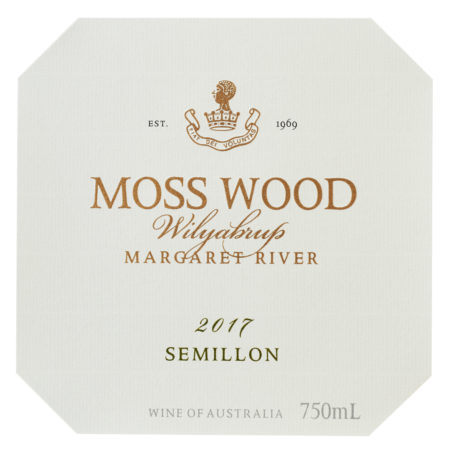Moss Wood 2017 Semillon

Wine Facts
| Median Harvest Date: | 23/03/2017 |
| Bottled: | 11 /07/2017 |
| Released: | 17/10/2017 |
| Yield: | 6.48 t/ha |
| Mean Harvest Ripeness | 12.5⁰ Baume |
| Alcohol: | 13.5% |
Moss Wood Semillon’s 40th Birthday
In 2017, Margaret River has been in the grip of nostalgia, celebrating the 50th anniversary of the planting of Vasse Felix, the first commercial vineyard in the modern era.
For Moss Wood, 2017 is the 40th birthday of Moss Wood Semillon. Please indulge us while we reflect on the life of our unsung variety.
It started with the original and brave decision by the Pannells to ignore Riesling, the dominant white wine of the time, and instead plant Semillon. It was intuitive thinking that proved correct. With time is has become clear Dr. John Gladstones’ prediction that Margaret River’s climate would be suitable for the Bordeaux varieties was correct. Yes, Cabernet Sauvignon has been the poster child but Semillon has done just as well.
The first vintage hinted at what was to come. In 1976, the Pannells made a tiny batch of Semillon and experimented with barrel fermentation and aging. They were happy with the result but felt the wood impacted too much and decided since it didn’t quite meet the required quality standard, it couldn’t be sold. Nevertheless, they were happy for people to try the wine and many experienced tasters were impressed. One fan, the Governor of Western Australia, Sir Wallace Kyle, convinced the Pannells to supply the wine to Government House for a dinner in honour of the visit by Queen Elizabeth 2nd during the Silver Jubilee Tour of 1977. For the fledgling Margaret River industry and for Moss Wood in particular, it was a huge thrill.
In 1977, the first commercial Semillon was made with classic Hunter Valley technique, still used today, with no barrel treatment. As with the 1976, the ’77 also turned heads and not only experienced tasters. A final year Oenology student at Roseworthy College named Keith Mugford had heard of the exciting new region of Margaret River but had never tasted any wines. This was until a dinner in 1978 with two Western Australian colleagues, John Elliott of the Western Australian Dept. of Agriculture and Dr Michael Peterkin, now the famous owner and winemaker of Pierro. John brought a bottle of the Moss Wood 1977 Semillon. Keith was really impressed and noted he should look out for Moss Wood wines in the future. In a remarkable coincidence, later that year he was offered the chance to work there.
With these and many other stories, Semillon is close to our hearts. It grows like a weed, ripens reliably and produces wines that are lively and vibrant in their youth but cellar for decades - a true, unsung hero.
Tasting Notes
The wine has medium straw colour, with some green tints and its condition is bright. On the nose it is ethereal, with lifted perfumes of lemon sherbet, green apples, honey suckle and figs. Underneath there is just some early suggestions of the variety’s complex features like lanolin and mushroom. We always expect our Semillon to be relatively firm as a youngster and this wine certainly has good acidity and tannin. However, the fruit flavours of limes, figs and lychees are rich, generous and mouth-filling, so the wine displays softness and drinkability only seen in the great years.
Vintage Notes
Ripening Time from Flowering to Harvest-2017 Moss Wood Semillon – 114 days
Reviewing the 2016/17 growing season, the notable feature is how mild it was. The vines set a very leisurely pace and went through flowering on 29th November, 8 days slower than average.
Rain was also a regular part of our lives. At 1248mm, rainfall for 2016 was way above our 1000mm average. During the flowering period, we received 44mm and there were10 days when temp dropped below 8⁰C. Not ideal conditions and probably responsible for yield of 6.48 tonnes per hectare, 36% down.
As much as we worry about rain damage, especially late in the season when the grapes have softened, in a year like 16/17, when precipitation is common, the vines become accustomed to it and there is less risk of rot. As the season progressed, we took comfort from this, especially as the showers just kept on coming.
Even old hands get nervous as the picking date looms and our confidence was tested in March as 60mm fell through the first 3 weeks. The Semillon was ripe at that point, so as soon as the rain cleared, off it came on 23rd March, 114 days after flowering, 7 days longer than the mean. For those who are good at maths, you can see, therefore, the harvest date was 2 weeks later than usual. Ripeness was spot on the average of 12.5⁰ Baume.
Production Notes
The fruit was hand-picked, whole bunch pressed and the juice was settled in stainless steel for 48 hours. The clear juice was then racked to stainless steel, where it was fermented using multiple yeast strains, with the temperature controlled at 18⁰C. After fermentation the finished wine was racked off lees, fined with bentonite for protein stability, then sterile filtered and bottled on 11th July, 2017.
Cellaring Notes
At Moss Wood we liken 2017 to 1990, one of our very finest. They are remarkably similar. This being the case, and knowing how well the ’90 aged, we have very high cellaring expectations of the new one. It will require at least a decade to build some of the bottle bouquet of toast and butter and it will be a further decade before it is fully mature. Beyond that the wine will continue to develop and should cellar until at least 30 years old.
